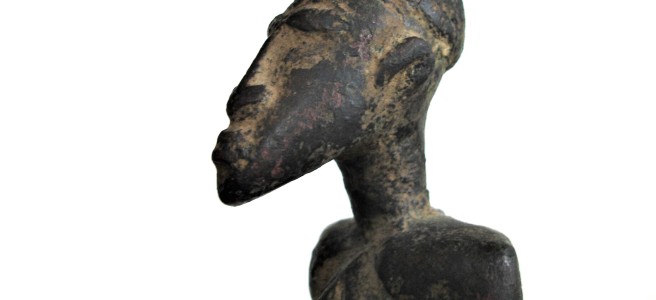By Jock Ireland.
Maybe 10, maybe 20 years ago, I bought a small sculpture from a friend, a guy who really loved not just African art, but everything about Africa. When he showed me the sculpture, he told me two things that I remember: the sculpture was from a mysterious, old city called Djenne, close to the edge of the Sahara Desert—and the ribs on the figure were showing because it represented a man starving to death. My heart skipped a beat when my friend told me about the ribs.
I did a little research about Djenne—discovered what I refer to as Djenne terracottas: there are two I know about in New York: one in the permanent collection at the Met, and one I remember seeing at the Brooklyn Museum (though I can’t find an image of it now). These have been “favorite” (whatever that means) sculptures mine ever since I first saw them.
My friend died about a year ago. How I wish I could have visited the great “Sahel: Art and Empires on the Shores of the Sahara” show that opened at the Met on January 30 with him! I can’t say exactly how my little sculpture fits in with all the work at the Met, but I’m sure it does. And I think my little sculpture and the show at the Met have something important to say to us all now, living as we are with the coronavirus. I really hope the Sahel show will still be up when the Met reopens in July.
It’s very hard to say what art has “to say.” The Djenne terracotta in the Met’s permanent collection seems to have collapsed in despair. I was surprised by the vitality and the varieties of vitality in the Djenne terracottas in the Sahel show. If my little figure is dying of starvation, it’s certainly not despairing. There’s something dignified about the gesture of its left arm, something defiant about the way its chin sticks out.
Maybe my little figure is a fake. I doubt it. My friend wasn’t in the art business for the money. Also, I “trust” the sculpture itself. It’s quite heavy, solidly cast in some kind of bronze I guess. It’s NOT made of plastic. And it’s beautifully put together: the proportions are musical; there’s a “wholeness” to the design.
It’s surprising how this thing—from a foreign place, a foreign time—speaks so directly to me (to us?) now. What is it saying? I don’t know, but I read a review by Joy Williams of some books by and about the terrific American novelist Robert Stone in the current Bookforum this morning. Williams quotes Stone reflecting on his own work—but he might be the author of my little figure:
“The American condition. The varieties of love. The ways in which people insist on perceiving their salvation in each other and the ways in which they fail each other or otherwise, sometimes, come through. The suspicion, the hope that there may be comfort for us on some level of things we cannot understand. . .”
March 31, 2020 New York






Your sculpture speaks to me also, and likewise I do not know exactly why. Its ribs show but many aboriginal people were very lean from all their activity to get enough food and food’s scarcity. Nevertheless, he remains standing, stoically, the artist commemorating him with very satisfying form.
LikeLike
Hi all, that is so beautiful, I really love this part in the Met and always find my way there. thanks !!!! hagar
hagarfletcher.com
LikeLiked by 2 people